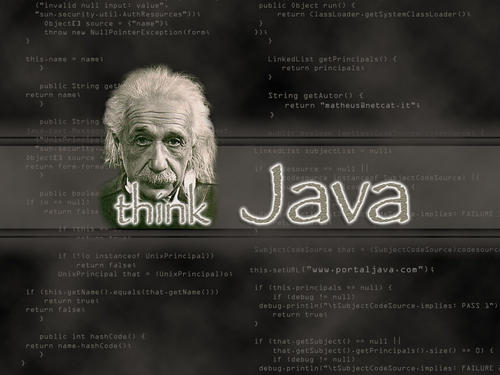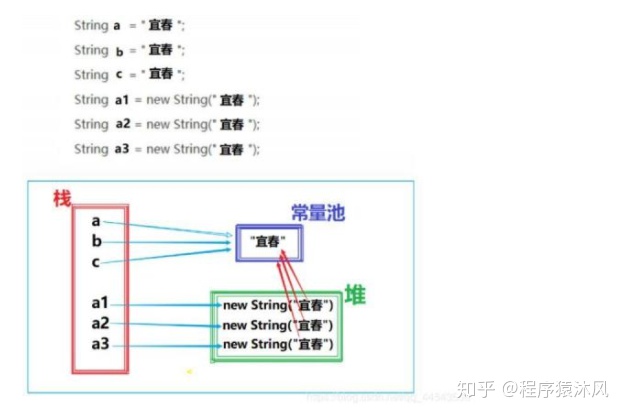
前言
相信很多读者关于==和equals懂了又懵,懵了又懂,如此循环,事实上可能是因为看到的博客文章之类的太多了,长篇大论,加上一段时间的洗礼之后就迷路了。本篇文章再一次理清楚。当然如果觉得本文太啰嗦的话,当然我也考虑到了,因为我也不喜欢长篇大论啰里啰嗦比比叨叨胡搅蛮缠的文章,毕竟大家入门java 的时候就知道个大概了,因此记住一句话就好了:equals本身和 == 没有区别,对于基本数据都是比较值,对于引用类型,则比较的是所指向的对象的地址!其他类在继承Object类之后对equals方法重写,所以表现的是比较里面的内容!具体比较的则要看自己是怎么重写的。
好了,如果有兴趣的就看下文,当然不感兴趣的大佬可以点个赞直接走了,不用看了,会了还看个*啊,楼主你个憨憨(皮一下很开心)
1、原生的equals()方法本身与 “ == ”没有任何区别!
从java语言本质上来讲,"=="属于JAVA语言的运算符,而equals则是根类Object的一个方法。
关于Object类的equals()方法,我们可以看看其源码
/* * @param obj the reference object with which to compare. * @return {@code true} if this object is the same as the obj * argument; {@code false} otherwise. * @see #hashCode() * @see java.util.HashMap */public boolean equals(Object obj) { return (this == obj);}是的,equals底层其实就是“ == ”,也就是说,原生的equals()方法本身与 “ == ”没有任何区别!唯一的区别则是基本类型没有继承Object类,所以基本类型没有equals()方法,也就是说基本类型只能使用“ == ”判断值是否相等。
既然原生的equals()方法本身与 “ == ”没有任何区别,那么我们对运算符 “ == ”的使用有所了解即可!
运算符 “ == ”其具体作用是用来比较值是否相等,这里分两中情况:
- 1、基本数据类型的变量,则直接比较其存储的 “值”是否相等;
- 2、引用类型的变量,则比较的是所指向的对象的地址是否相等;
到这里我们可以初步确认原生的equals()方法本身与 “ == ”没有任何区别!作用正是如上。
下面是我们的一个专栏 《Java 进阶集中营》,有兴趣的朋友们可以关注一下!JAVA 进阶集中营zhuanlan.zhihu.com

2、equals()方法的重写
但是重点来了,因为对于equals()方法我一直在强调原生二字。是的,让很多初学者疑惑的点就在这里:equals()方法的重写!
在JDK中,诸如String、Date等类对equals方法进行了重写,以String为例,这里感兴趣的读者可以一起看看String类中重写的equals()方法,当然跳过也问题不大
/** * Compares this string to the specified object. The result is {@code * true} if and only if the argument is not {@code null} and is a {@code * String} object that represents the same sequence of characters as this * object. * * @param anObject * The object to compare this {@code String} against * * @return {@code true} if the given object represents a {@code String} * equivalent to this string, {@code false} otherwise * * @see #compareTo(String) * @see #equalsIgnoreCase(String) */ public boolean equals(Object anObject) { if (this == anObject) { return true; } if (anObject instanceof String) { String anotherString = (String) anObject; int n = value.length; if (n == anotherString.value.length) { char v1[] = value; char v2[] = anotherString.value; int i = 0; while (n-- != 0) { if (v1[i] != v2[i]) return false; i++; } return true; } } return false; }从源码中可以看出,首先该方法判断比较的是所指向的对象地址是否相等,如果相同直接返回true,如果不相同进行下一个if判断,第二个if判断大致意思则是比较其存储的 “值”是否相等,也就是比较内容值!相同就返回true,比如两个new String对象“AAA”和“AAA”,这里虽然对象地址不相等,但是内容相等,所以同样返回true。
这里我就想给各位出个典型的String例子了:
public static void main(String[] args) { String a = "宜春"; String b = new String("宜春"); String c = b; //注意这里是引用传递,意思是c也指向b指向的内存地址 System.out.println(a == b); //false System.out.println(a == c); //false System.out.println(b == c); //true System.out.println(a.equals(b)); //true System.out.println(a.equals(c)); //true System.out.println(b.equals(c)); //true }【特别注意:String类型属于引用类型】
解析:(1)a == b?意思是地址指向的是同一块地方吗?很明显不一样。
(2)a == c?意思是地址指向的是同一块地方吗?很明显不一样。
(3)b == c?意思是地址指向的是同一块地方吗?很明显内容一样,所以为true。
(4)a.equals( b )?意思是地址指向的内容一样嘛?一样。
(4)a.equals( c )?意思是地址指向的内容一样嘛?一样。
(4)b.equals( c )?意思是地址指向的内容一样嘛?一样。
当然,你可能还是有点疑惑,那么结合下面这张图再理解上面的解析,你可能就恍然大悟了

OK。现在能理解嘛?你你你......不用回答,我知道你理解了(理直气壮)。当然值得注意一点的是String中intern()方法,先看一段程序:
public static void main(String[] args) { String a = "宜春"; String b = new String("宜春"); b=b.intern(); System.out.println(a == b); //true System.out.println(a.equals(b)); //true }intern方法的意思是检查字符串池里是否存在,如果存在了那就直接返回为true。因此在这里首先a会在字符串池里面有一个,然后 b.intern()一看池子里有了,就不再新建new了,直接把b指向它。
3、为什么要重写equals方法?
不知道大家有没有想过这个问题。当然答案也是很简单的,因为程序员比较字符串一般比较其内容就好了,比较内存地址是不是同一个对象就好像没啥意义了,重写equals方法就很方便用来比较字符串的内容了。
其实除了诸如String、Date等类对equals方法进行重写,我们在实际开发中,我们也常常会根据自己的业务需求重写equals方法.
举个栗子:我们的需求就是如果两个学生对象姓名、身份证号、性别相等,我们认为两个学生对象相等,不一定需要学生对象地址相同。
学生A的个人信息(姓名:如花,性别:女,身份证号:123,住址:广州),学生A对象地址为0x11, 学生B的个人信息(姓名:如花,性别:女,身份证号:123,住址:深圳),学生A对象地址为0x12,
这时候如果不重写Object的equals方法,那么返回的一定是false不相等,这个时候就需要我们根据自己的需求重写equals()方法了。具体equals方法的重写代码如下:
// 重写equals方法 @Override public boolean equals(Object obj) { if(!(obj instanceof Student)) { // instanceof 已经处理了obj = null的情况 return false; } Student stuObj = (Student) obj; // 对象地址相等 if (this == stuObj) { return true; } // 如果两个对象姓名、身份证号码、性别相等,我们认为两个对象相等 if (stuObj.name.equals(this.name) && stuObj.sex.equals(this.sex) && stuObj.IDnumber.equals(this.IDnumber)) { return true; } else { return false; } }开发中这样设计,才能符合我们的生活!到这里我就不信了你还搞不定==和equals!
可是一涉及重写equals方法的同时又衍生了下面一个问题。
4、重写equals方法之后要不要重写hashCode()方法?
当然这个问题要讨论,又要长篇大论哔哔一大堆了,有空写一篇这样的文章吧专门讨论讨论这个问题,当然园子里的大佬们也写了一大堆!可以自行去了解了解。本篇文章简单聊聊,点到即可。
首先hashCode()方法是Object类的一个方法,源码如下:
/** * Returns a hash code value for the object. This method is * supported for the benefit of hash tables such as those provided by * {@link java.util.HashMap}. * <p> * The general contract of {@code hashCode} is: * <ul> * <li>Whenever it is invoked on the same object more than once during * an execution of a Java application, the {@code hashCode} method * must consistently return the same integer, provided no information * used in {@code equals} comparisons on the object is modified. * This integer need not remain consistent from one execution of an * application to another execution of the same application. * <li>If two objects are equal according to the {@code equals(Object)} * method, then calling the {@code hashCode} method on each of * the two objects must produce the same integer result. * <li>It is <em>not</em> required that if two objects are unequal * according to the {@link java.lang.Object#equals(java.lang.Object)} * method, then calling the {@code hashCode} method on each of the * two objects must produce distinct integer results. However, the * programmer should be aware that producing distinct integer results * for unequal objects may improve the performance of hash tables. * </ul> * <p> * As much as is reasonably practical, the hashCode method defined by * class {@code Object} does return distinct integers for distinct * objects. (This is typically implemented by converting the internal * address of the object into an integer, but this implementation * technique is not required by the * Java<font size="-2"><sup>TM</sup></font> programming language.) * * @return a hash code value for this object. * @see java.lang.Object#equals(java.lang.Object) * @see java.lang.System#identityHashCode */ public native int hashCode();可以看出hashCode()方法返回的就是一个int数值,从方法的名称上就可以看出,其目的是生成一个hash码。hash码的主要用途就是在对对象进行散列的时候作为key输入,据此很容易推断出,我们需要每个对象的hash码尽可能不同,这样才能保证散列的存取性能。
事实上,Object类提供的默认实现确实保证每个对象的hash码不同(在对象的内存地址基础上经过特定算法返回一个hash码)。Java采用了哈希表的原理。哈希算法也称为散列算法,是将数据依特定算法直接指定到一个地址上。初学者可以这样理解,hashCode方法实际上返回的就是对象存储的物理地址(实际上不是)。
想要知道hashCode的作用,必须要先知道Java中的集合。
Java中的集合List的元素是有序的,元素可以重复;Set元素无序,但元素不可重复。这我们都清楚。但是你有没有想过这样一个问题:要想保证元素不重复,可两个元素是否重复应该依据什么来判断呢?
每错这里就是用Object.equals方法了。但是,如果每增加一个元素就检查一次,那么当元素很多时,后添加到集合中的元素比较的次数就非常多了。也就是说,如果集合中现在已经有1000个元素,那么第1001个元素加入集合时,它就要调用1000次equals方法。这显然会大大降低效率。
那怎么解决呢?我们可以在Java集合框架中得到验证。由于HashSet是基于HashMap来实现的,所以这里只看HashMap的put方法即可。源码如下:
public V put(K key, V value) { if (table == EMPTY_TABLE) { inflateTable(threshold); } if (key == null) return putForNullKey(value); int hash = hash(key); //这里通过哈希值定位到对象的大概存储位置 int i = indexFor(hash, table.length); for (Entry<K,V> e = table[i]; e != null; e = e.next) { Object k; //if语句中,先比较hashcode,再调用equals()比较 //由于“&&”具有短路的功能,只要hashcode不同,也无需再调用equals方法 if (e.hash == hash && ((k = e.key) == key || key.equals(k))) { V oldValue = e.value; e.value = value; e.recordAccess(this); return oldValue; } } modCount++; addEntry(hash, key, value, i); return null;}正如源码中注释所述,“&&”具有短路的功能,只要hashcode不同,也无需再调用equals方法。是的,Java采用了哈希表的原理。 哈希表具有优越的查询性能,就像九九乘法表2*3=6你能很轻易知道,但是哈希表难免还会出现哈希冲突,只是概率极低。
如此设计,这样一来,当集合要添加新的元素时,先调用这个元素的hashCode方法,就一下子能定位到它应该放置的物理位置上。如果这个位置上没有元素,它就可以直接存储在这个位置上,不用再进行任何比较了;如果这个位置上已经有元素了,就调用它的equals方法与新元素进行比较,相同的话就不存,不相同就散列其它的地址。所以这里存在一个冲突解决的问题。这样一来实际调用equals方法的次数就大大降低了,几乎只需要一两次。
因此并不是重写了equals方法就一定要重写hashCode方法,只有用到HashMap,HashSet等Java集合的时候重写了equals方法就一定要重写hashCode方法。用不到哈希表仅仅重写equals()方法也OK的。
Java官方建议 重写equals()就一定要重写hashCode()方法。毕竟实际开发场景中常常用到Java集合
5、eqauls方法和hashCode方法关系
Java对于eqauls方法和hashCode方法是这样规定的:
1、如果两个对象equals为true ,他们的hashcode一定相等。2、如果两个对象equals为false,他们的hashcode有可能相等。3、如果两个对象hashcode相等,equals不一定为true。4、如果两个对象hashcode不相等,equals一定为false。
最后,若有不足或者不正之处,欢迎指正批评,感激不尽!














)
)



